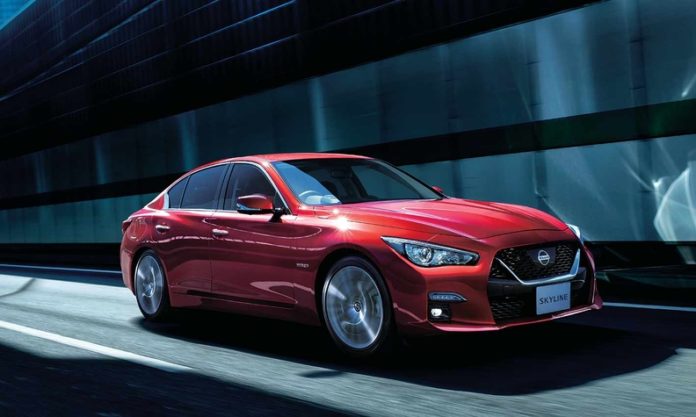The minor model change, unveiled at Nissan’s headquarters here south of Tokyo, also gets a top-tier 400R grade in Japan that is the most powerful factory-built Skyline ever. Its 3.0-liter V-6 twin-turbo engine generates 400hp, over the base model’s 300 hp.
The engine was already deployed in the U.S.-market Infiniti Q50 but now makes its way to Japan, replacing a Daimler-supplied 2.0-liter inline four-cylinder turbocharged engine.
The prominent Nissan branding — with the return of Nissan logos — reverses an earlier attempt to position the current model simply as “Skyline,” stripped of any corporate badging. That move was seen by some as testing the waters for a possible introduction of the Infiniti brand to Japan.
“By delivering these new products before anyone else, we have been unlocking the future of mobility,” Executive Vice President Asako Hoshino said at the launch.
“This is the first product that enables hands-off driving in certain circumstances in assisting the driver on multilane highways. This is a technology only Nissan can develop,” she said.
The new ProPilot 2.0 system makes several advances over the first generation ProPilot technology, which has been sold in 350,000 vehicles worldwide since hitting the market in 2016. Chief among the improvements is delivering pure hands-off highway driving from on-ramp to off-ramp. The system will switch lanes, pass other cars and help with lane exiting.
The current system does not allow lane changing or take orders from the navigation system to drive itself to a chosen destination. Indeed, in the U.S., a circumspect Nissan tacks on the word “Assist” to ProPilot so as not to engender a false sense of security in its limited abilities.
Nissan said in a statement that ProPilot 2.0 delivers “the world’s first driver assistance system to combine navigated highway driving with hands-off single-lane driving capabilities.”
The new system fulfills Nissan’s promise to launch an auto-navigating, self-driving system for highways by the end of the decade. ProPilot 2.0 joining together seven cameras, five radar sensors and 12 sonar sensors, combined with a 3D high-definition mapping navigation system.
The technology can pinpoint the car’s location to within 5 centimeters, said Kunio Nakaguro, executive vice president for r&d and product development. The system allows hands-off driving only when the car is traveling in the same lane. When the car switches lanes, Japanese regulations require drivers to have their hands on the wheel. ProPilot 2.0 still changes the lanes by itself, but the law requires human hand-holding, just in case.
Nissan said in May the 2.0 system will be available only in Japan for the time being. Nissan plans to eventually introduce it worldwide, but the timing of the global rollout is still under discussion.
The system uses a driver monitoring system to make sure the driver is paying attention and ready to resume control in an emergency. If the driver becomes disengaged and does not respond to alerts, the car turns on its hazard lights, slowly pulls over to a stop and calls for emergency help.
A key function of the upgrade is the ability to set a destination in the navigation system and have the car drive itself there, at least over certain highway routes where the technology works. Nissan calls that a world’s first when combined with hands-free driving.
Like the Leaf electric car, Nissan’s autonomous driving push is a forward-looking legacy of Carlos Ghosn, the former chairman who was arrested Nov. 19 and now faces four indictments in Japan on allegations of financial misconduct during his time at Nissan’s helm.
While CEO, Ghosn announced plans in 2013 to have multiple autonomous vehicles on the market by 2020. Nissan later fine-tuned the plan, saying a multi-lane highway system would debut around 2018 and that an urban system that handles intersections would arrive around 2020.
Autonomous driving is now a key pillar of Nissan’s so-called Intelligent Mobility product development strategy, which focuses on electrification, autonomy and connectivity.
Nissan CEO Hiroto Saikawa said in May he wants annual sales of vehicles equipped with ProPilot semi-autonomous driving systems to reach 1 million units in the next four years.




